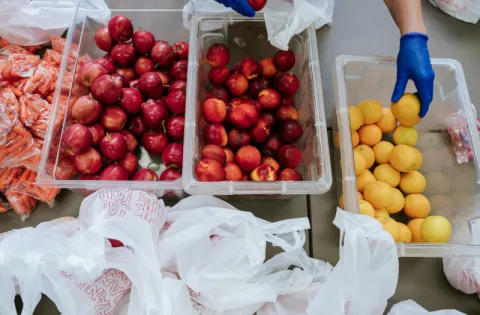Summer is typically the hungriest time of year for kids. No Kid Hungry convened a panel of experts to explore our urgent need to update and modernize the summer meals programs by building on proven, successful changes implemented during the COVID-19 pandemic.
The COVID-19 pandemic caused record hunger and hardship in our country. As a result, this summer, as many as 13 million children are at risk of hunger.
Thanks to recent policies, however, this year many of these kids will get the food they need.
“We know there are more kids going hungry now than pre-pandemic,” said Lisa Davis, Senior Vice President of Share Our Strength’s No Kid Hungry campaign. “But I also feel really good about this summer.”
A number of measures put in place during the pandemic not only helped alleviate the hunger crisis in the summer of 2020, but also addressed barriers kids and families faced long before the crisis hit.
“Even in a suburban area that’s near a large metropolis like Metro Atlanta, you still have the challenge of children being able to access meals,” said Abdul Lindsay, School Nutrition Director for Newton County School District in Covington, Georgia. “Limited transportation is one of the issues.”
School nutrition waivers issued by the U.S. Department of Agriculture have been critical in breaking down barriers to accessing summer meals, allowing meal providers to reimagine how they get nutritious food to kids in need, no matter where they live.
“Particularly in rural areas, the logistics -- simply getting hot meals delivered to certain very rural areas is tough,” said Dr. Ryan Quarles, Commissioner of the Kentucky Department of Agriculture. “In order for us to legally pass out school lunches and breakfasts [during the pandemic], we had to get a waiver. That was a really big thing for us.”
According to Commissioner Quarles, Kentucky was one of the first states to receive these critical waivers.
“We actually helped buy some school buses that were out of service and retrofitted them with refrigerators and heating units, even picnic tables inside,” Commissioner Quarles added. “So school buses that used to pick up and drop off kids that were now learning at home were now being used to drop off food.”
These waivers, in part, helped break down another common barrier around congregate meal rules, which require kids to eat meals at a specific location for a specific amount of time. Instead, summer meal providers were able to bring meals to kids rather than require kids to go to meal sites. For example, parents were able to pick up multiple meals at a time to bring home for kids, or meals could be dropped off at a child’s home.
And the waivers worked.
“We saw an increase in our participation from the previous year,” said Lindsay. “A 100% increase in participation because we were able to have more flexibility in how we get the meals to the kids.”
This success wasn’t isolated either.
“Last July, we saw [nationwide] summer meals increase by 160% as compared to the previous July,” added Davis. “In the middle of a pandemic, when a lot of people were still kind of afraid to come out of their homes. So we know that those flexibilities are a critical lever to closing that summer meal gap.”
Another measure that helped at the height of the crisis was a program called Pandemic EBT, which provides families with a modest grocery benefit when school meals can’t be accessed.
“[Pandemic EBT] was based on a small pilot program called Summer EBT that the USDA evaluated and found reduced food insecurity very significantly, by almost a third, and it increased children’s consumption of healthy foods,” said Davis. “Because those two pieces (flexibilities and Pandemic EBT) will be in play this summer, I actually think that we’re about to enter the least hungry summer in probably my lifetime.”
This matters. Making sure kids are nourished during the summer months has a strong return on investment. Summer hunger is linked to summer learning loss as well as a higher likelihood of illnesses and emotional stress. When kids get the food they need, it helps them stay active and healthy during the summer and return to school in the fall ready to learn.
“I would challenge any corporate CEO to find an investment with a better ROI,” Davis added.
While today there are more of the right programs and policies in place that will reach more kids in need, the work isn’t done.
Making these measures that have worked, especially under difficult circumstances, permanent is the next step.
Congress has the power to make these changes through a process called Child Nutrition Reauthorization, or CNR, which sets the policies for child nutrition programs like school meals and summer meals. Along with the Biden Administration’s latest proposal, the American Families Plan, these are some of the best vehicles for modernizing and changing how our nation feeds children in need.
Here are a few of No Kid Hungry’s recommendations for practical, effective policy solutions to close the summer meals gap:
- Permanently authorize and expand Summer EBT nationwide
- Authorize alternatives to the “congregate” requirements and other flexibilities
- Expand access to summer meals by lowering the eligibility threshold
- Streamline existing meal programs to reduce red tape and bureaucracy
If you'd like to help, visit No Kid Hungry’s Free Meal Finder service and spread the word about how to find free meals in your community. As chef Tiffany Derry noted, “Knowledge is power. So many people don’t know that there’s so many kids hungry. There are so many programs already available, we just need people to know.”
You can visit nokidhungry.org to learn more about finding free meals in your community. Because, as Derry said, “a simple meal can feel like love.”



